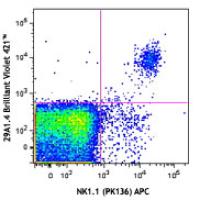-
Sign In
-

-
 Sony Biotechnology
Sony Biotechnology
-

-
 Sony Biotechnology
Sony Biotechnology
Brilliant Violet 421™ anti-mouse CD335 (NKp46)
Antibodies Single
Sony
29A1.4
Flow Cytometry
Rat IgG2a, κ
Mouse
NKP46-IgG1 Fc fusion protein
1288055
$214.00
Description
CD335, also known as NKp46, is a single-pass type I membrane protein of 46 kD. It belongs to the natural cytotoxicity receptor (NCR) family and contains two Ig-like (immunoglobulin-like) domains. It's expression is restricted to NK cells and a subset of NKT cells; it's not expressed in CD1d-restricted NKT cells. CD335 is a receptor for viral hemagglutinins and heparan sulfate proteoglycans and is involved in NK cell activation.
Formulation
Phosphate-buffered solution, pH 7.2, containing 0.09% sodium azide and BSA (origin USA).Recommended Usage
Each lot of this antibody is quality control tested by immunofluorescent staining with flow cytometric analysis. For immunofluorescent staining using the microg size, the suggested use of this reagent is ≤0.5 microg per million cells in 100 microL volume. For immunofluorescent staining using the microL size, the suggested use of this reagent is ≤5 microL per million cells or 5 microL per 100 microL of whole blood. It is recommended that the reagent be titrated for optimal performance for each application.
Brilliant Violet 421™ excites at 405 nm and emits at 421 nm. The standard bandpass filter 450/50 nm is recommended for detection. Brilliant Violet 421™ is a trademark of Sirigen Group Ltd.
This product is subject to proprietary rights of Sirigen Inc. and is made and sold under license from Sirigen Inc. The purchase of this product conveys to the buyer a non-transferable right to use the purchased product for research purposes only. This product may not be resold or incorporated in any manner into another product for resale. Any use for therapeutics or diagnostics is strictly prohibited. This product is covered by U.S. Patent(s), pending patent applications and foreign equivalents.
References
1. Walzer T, et al. 2007. P. Natl. Acad. Sci. USA 104:3384. (FC, Activ)
2. Walzer T, et al. 2007. Nat. Immunol. 8:1337. (FC, Activ)
3. Guerriero JL, et al. 2011. J. Immunol. 186:3517. (IHC) PubMed


